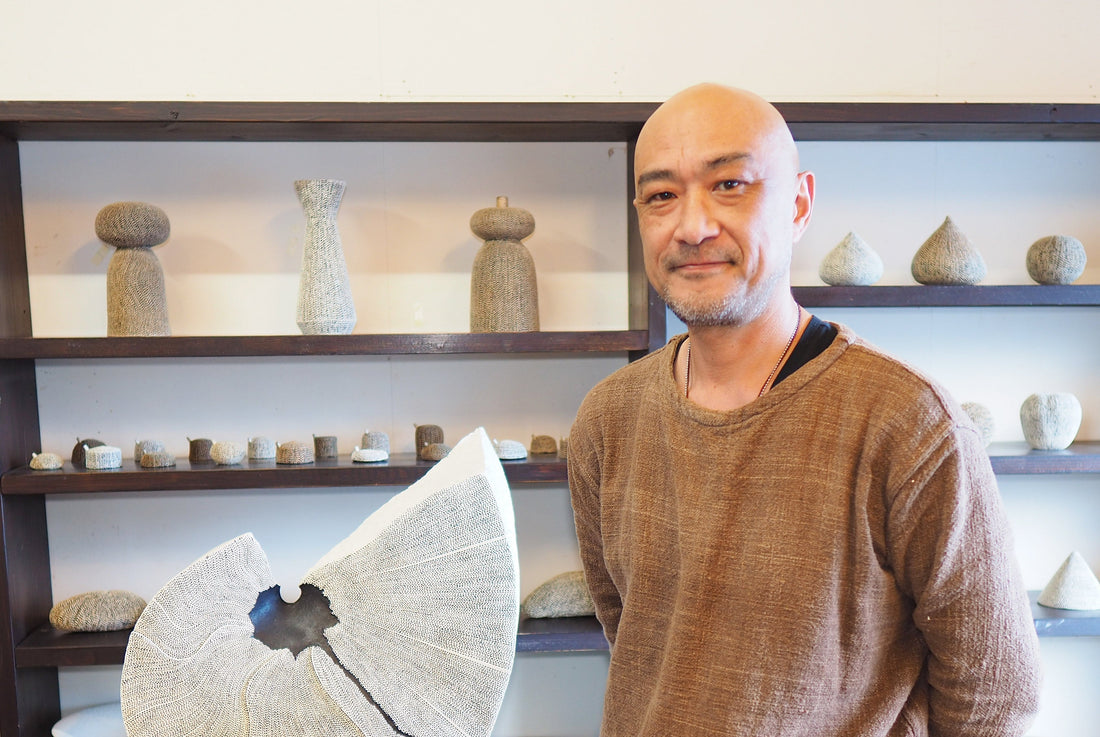
Interview with Daisuke Tomioka
A unique world woven by clay and glaze.
The beauty of inscriptions
Profile/Ceramics history
(Tomioka Daisuke)
Born in Ogaki City, Gifu Prefecture in 1973. After graduating from Kyoto Prefectural Ceramic Technical College in 1994, he studied under ceramic artists Kato Kai and Kato Reikichi. In 2002, he built his kiln in Ikeda Town, Gifu Prefecture.
(Awards and activities as of 2025)
In 1995, he was selected for the 5th Nihon Kogyokai Exhibition and the 1995 Ceramic Art Biennale. He has since been selected for the Nitten Exhibition over a dozen times, with one non-judging award. In 1999, he won the Newcomer Award at the 9th Nihon Kogyokai Exhibition. That same year, he was selected for the Asahi Ceramic Art Exhibition 1999. In 2014, he received the Minister of Education, Culture, Sports, Science and Technology Award at the 24th Nihon Kogyokai Exhibition. In 2015, his work "Dot II" was designated a Mino Ceramic Art Permanent Preservation Work. In 2020, he received the Mino Ceramic Art Association's 6th Mino Ceramic Development Tomoko Award and the newly reorganized 7th Nitten Special Selection. In 2021, he won the Mino Ceramic Art Grand Prize at the 45th Mino Ceramic Art Exhibition. In 2023, he held a solo exhibition at Daisen-in Temple, Daitokuji Temple, Kyoto, and in 2024, he received the Nagoya Mayor's Award and the Chunichi Shimbun Award at the Nitten Nagoya Exhibition. In the same year, he again won the Special Selection at the 11th Nitten Exhibition.
Ikeda Town, Ibi District, Gifu Prefecture - A row of cherry blossom trees lines the Kuise River, which flows at the foot of Mount Ikeda. We visited ceramic artist Daisuke Tomioka in his studio, located nearby, overlooking lush greenery and a peaceful rural landscape.
Encounter with pottery
Tomioka was born and raised in Ogaki City, Gifu Prefecture. His father, who was from Shigaraki Town, ran a pottery business and used a hand-cranked potter's wheel as a hobby, which led him to pursue pottery, which was a familiar subject. He discovered the joy of pottery when he enrolled at Kyoto Prefectural Pottery Technical College, and thought, "It would be great if I could continue doing this as a career," and began to aspire to become an artist. After graduating, he trained under a potter in Seto City, Aichi Prefecture, before going independent in 2002. Wanting to continue working as a potter close to home, he found a piece of land in Ikeda Town, originally a plum and tea plantation, and set up his studio there.

Techniques and works
Tomioka's early works were characterized by "line patterns" made by forming clay into strings and pasting them on fabric, and he actively participated in public exhibitions, repeatedly winning prizes. However, after going independent, as he continued to create "line patterns," he began to feel a strong desire to "start something new and original."

Tomioka looks back on that time, saying, "Even though I was in a slump after being rejected from multiple exhibitions, I decided I would never go back to line drawings." At that time, he happened to pick up a copy of "Pollen Encyclopedia." The moment he saw the enlarged photo of pollen, he had an epiphany: "This is it!" Tomioka says, "I felt like I was in space."

He then began to think about how to express the vivid image of pollen he had in his head in clay, and how to create the minute details of the pollen. This led him to the idea of creating a series of small indentations. He began by pressing a wooden stick and trying to make small holes by sharpening the tip of the stick. He then tried using a bamboo skewer to make even smaller holes, but the tip quickly became rounded and the handle broke. He then tried using iron, but none of them produced a satisfactory result or feel. After much trial and error, Tomioka arrived at a piercing tool made of stone with a handle. He now selects hard stones such as quartz, turquoise, and onyx, and uses a diamond cutter to carve them into the ideal shape. One of the reasons Tomioka is so particular about his tools is largely related to the size of his works.

It takes between 10 and 20 days to pierce a large object. The work is always a race against time, with the fabric being sprayed with mist to prevent it from drying out. To make countless holes quickly and accurately, tools that are both durable and easy to use are essential. Tomioka has created patterns with countless continuous depressions using these homemade tools, which he calls "Tenkokumon" (pointed patterns) , and has developed them into works that have become synonymous with his name.
Career and Challenges
After creating his stippled writing, Tomioka continued to win awards at public exhibitions. Five years after he first got inspiration from the pollen encyclopedia, and around the beginning of the Reiwa era, Tomioka titled this work "Beginning." Measuring 50cm in length and width, it took him 80 hours to complete, and the countless holes radiating from the center represent the expanse of the universe. This work won a special award at the Nitten Fine Arts Exhibition, which Tomioka says was a particularly memorable award. "Beginning," which has since been adapted into a series with different designs and shapes, will again win a special award at the Nitten Fine Arts Exhibition in 2024.

To Tomioka, the countless tiny holes are particles of light in the universe. They are a symbol of life, the beginning of life that spreads infinitely. What he is expressing is the landscape of the beginning of eternal life .
The origin of this lies in a long plate by ceramic artist Kamoda Shoji that Tomioka saw at an art museum during his student days, which "felt as if it were alive." Kamoda Shoji left behind a memorable statement : "Just as you see an infinite universe outside of yourself, there is also an infinite universe within you," and Tomioka found the answer to the question of "whether you are expressing your own universe in your work ," and thought, "I wish I could express that too."

When creating a piece, Tomioka first decides on a goal: "What shape? What pattern? What color?" He then tries to get as close as possible to the finished product he has in mind, enhancing the artistic quality while respecting traditional techniques, and then goes on to try and error to turn it into a household item... Tomioka says that this is what he finds rewarding.
Outlook for the future
Although Tomioka has thus established his own style, his desire to explore new challenges never seems to end. Up until now, his stipple patterns have been created by creating a body, piercing the fabric one point at a time, applying a black coating after drying, scraping with sandpaper, and then applying a white coating. Recently, he has been working on pieces that add iron to the white coating, giving them a beige to brown hue. He also uses a technique that weathers silver with chlorine. He also says he would like to try his hand at "red stipple patterns," which involve using red pigment and applying a red coating.

Tomioka is always trying to change, and it seems his journey to express his own universe is still continuing.
(December 2024, Interview: Chika Shimura)
information
Tomioka Daisuke Workshop
1079-6 Miyaji, Ikeda-cho, Ibi-gun, Gifu Prefecture, 503-2409




